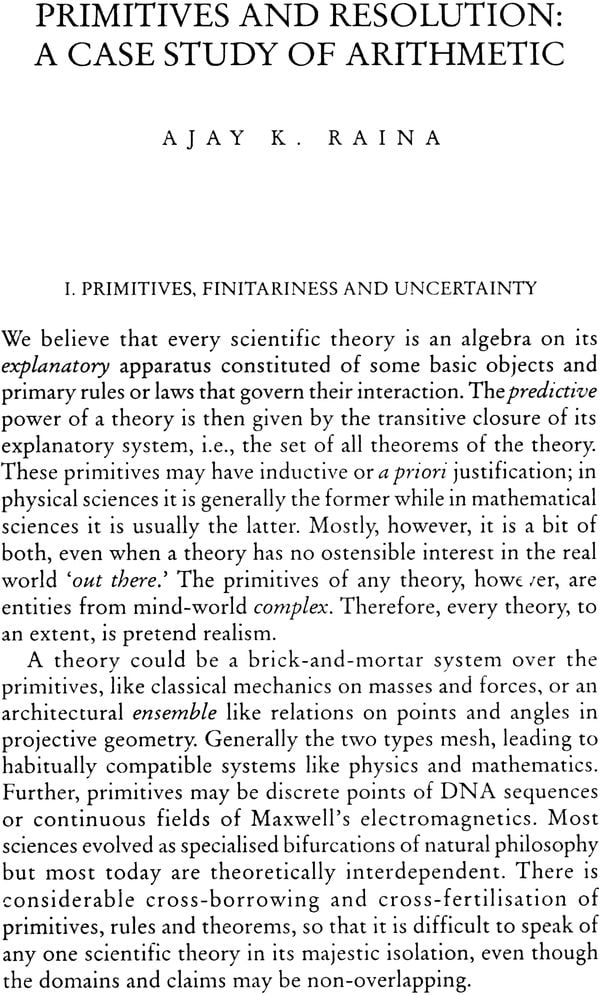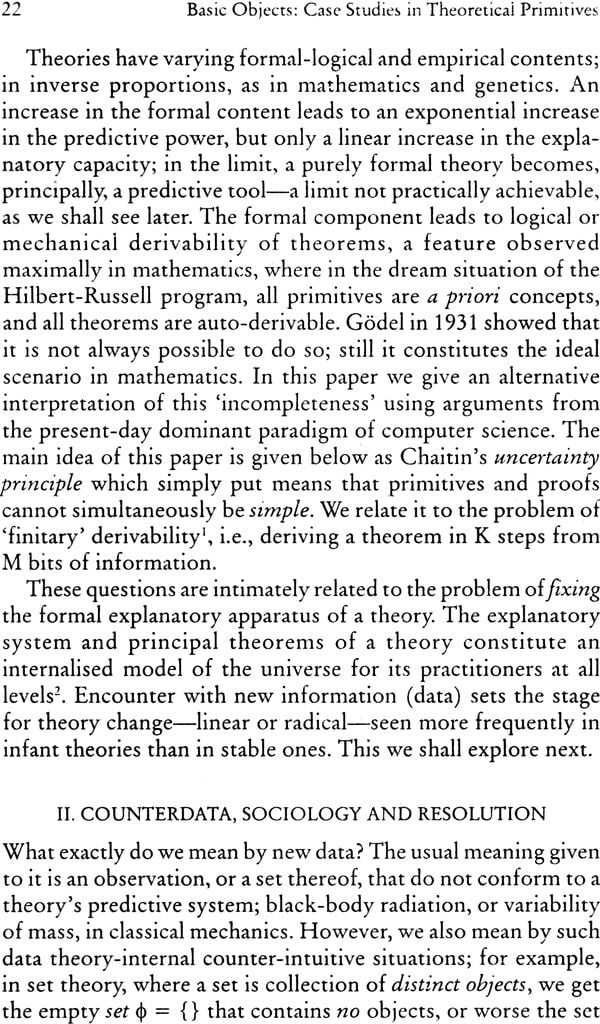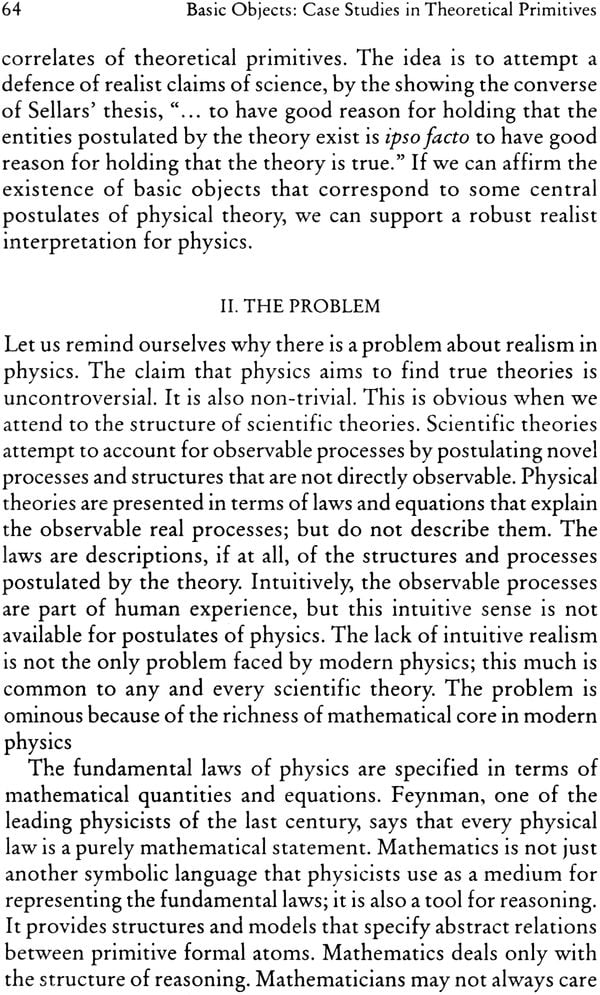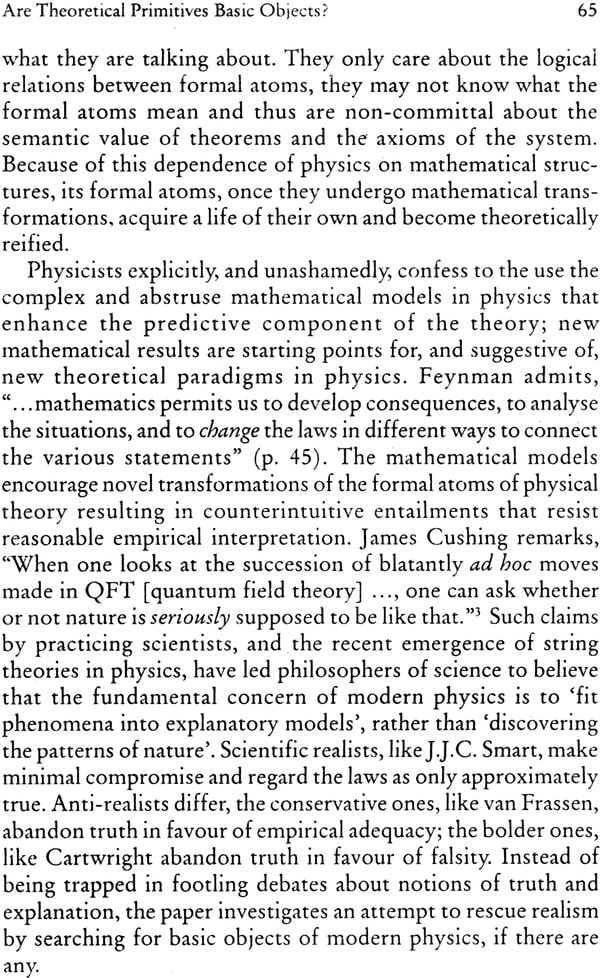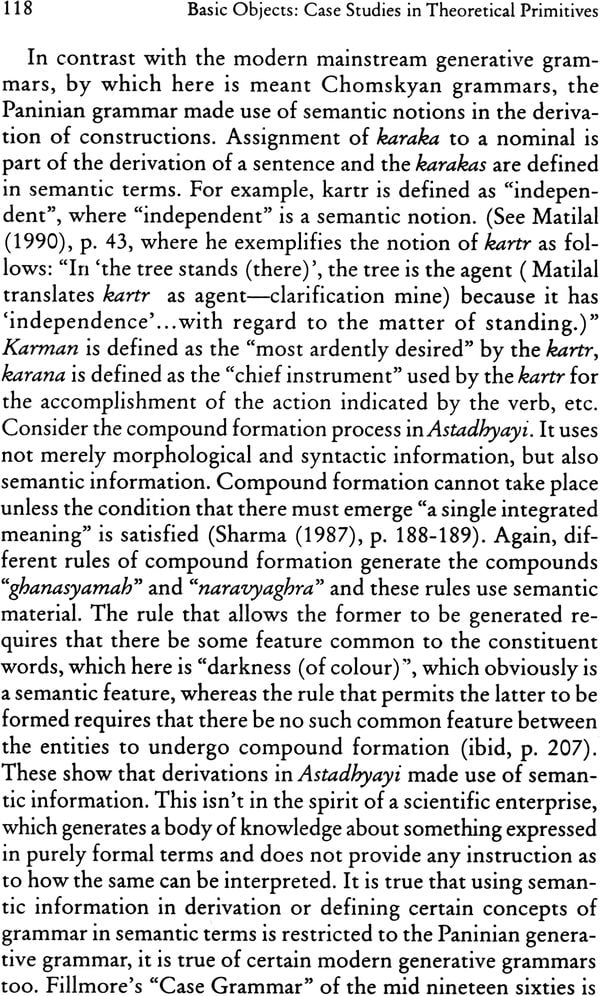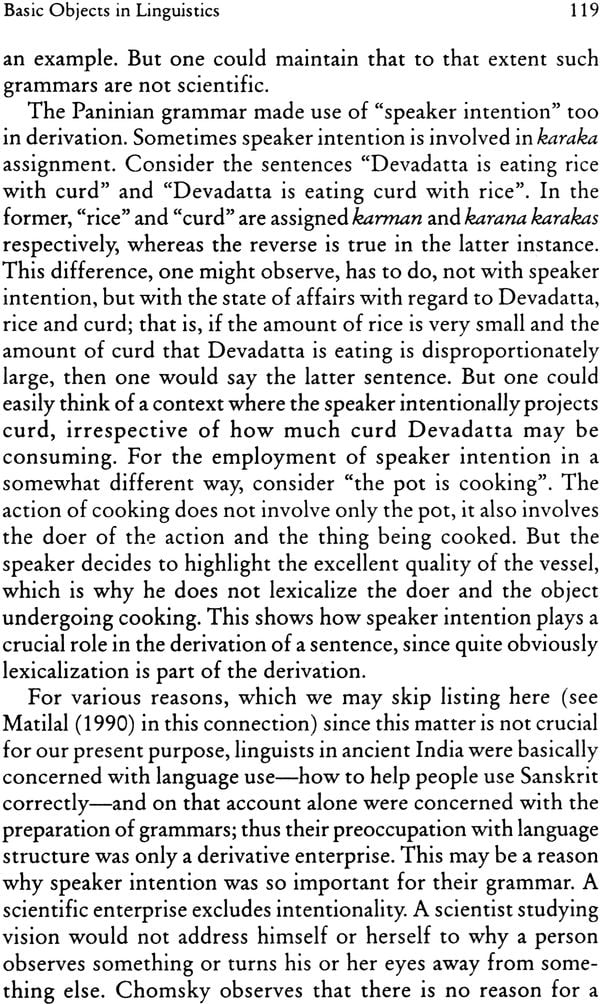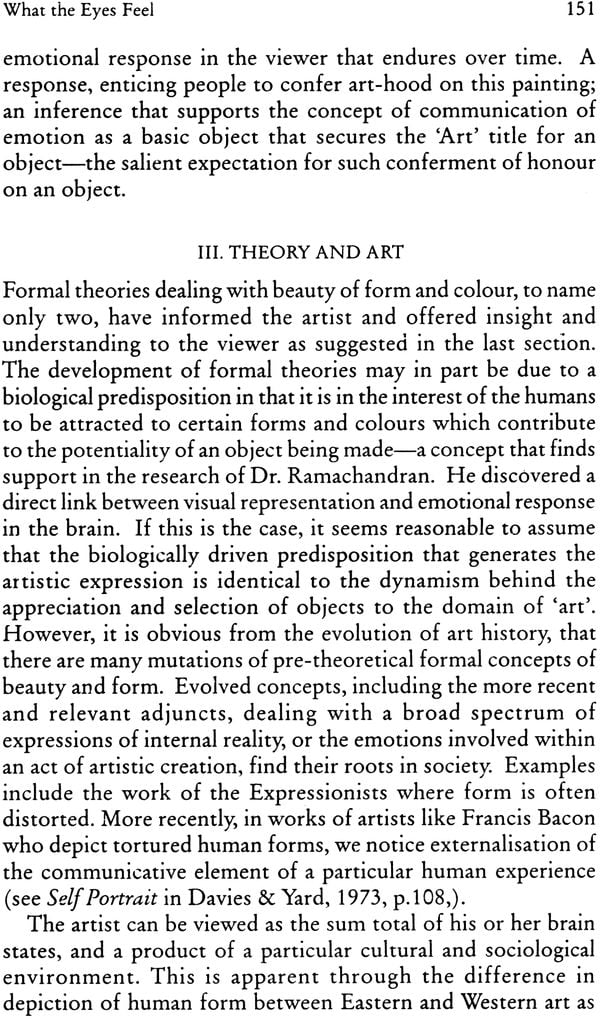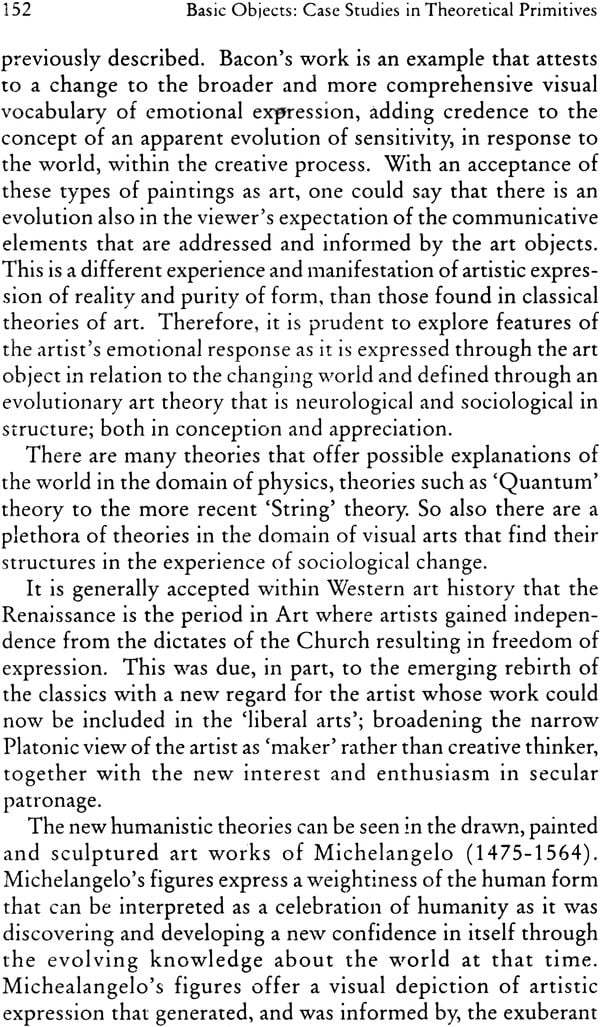
Basic Objects: Case Studies in Theoretical Primitives
Book Specification
| Item Code: | IDG166 |
| Author: | Monima ChadhaAjay K. Raina |
| Publisher: | Indian Institute Of Advanced Study, Shimla |
| Language: | English |
| Edition: | 2001 |
| ISBN: | 8179860019 |
| Pages: | 158 |
| Cover: | Hardcover |
| Other Details | 8.5" X 5.5" |
Book Description
About the Book:
The book dives deep into the ocean of Basic Objects which have unfathomable qualities. These Basic Objects have been taken from physics, arithmetic, language, sociology and other disciplines. It contains nine cases in theoretic primitives from national and international experts. The book presents intellectual panorama of highest metaphysical and scientific nature to the scholarly world.
About the Author:
MONIMA CHADHA is on the faculty of School of Philosophy, Linguistics, and Bio-ethics, Monash University. She was earlier with the Indian Institute of technology, Kanpur where she taught philosophy of language, Indian philosophy and philosophy of science. She is the author of Topics in Indian Philosophy, published by Monash Distance Education Centre.
A. K. RAINA is a Professor of electrical engineering at the Indian Institute of Technology, Kanpur. He works in mathematical theories of control and information processing. His other scholarly interest are in the history of philosophy of science and civilizations. He occasionally writes poetry. He is also a fellow of IETE and member of IEEE and a national expert for AICTE.
The Institute organized a study on Basic Objects in March 2000. The purpose of the seminar was to explore the hazy domain of ‘Basic Objects’. It is well known that all knowledge is an exploration of the real, the ultimate and the final in its metaphysical and scientific aspects. As such, all the science and all the arts have theories and postulates. In turn, all theories have pre-theoretic domain. If is from this domain that the formal primitives are evolved. Physics, arithmetic, language, sociology etc. have such stature. The purpose of the seminar was to dive deep into this ocean of basic objects which has unfathomable qualities.
The present monograph contains nine cases in theoretic primitive from national and international experts. These studies are highly stimulating and provocative and any researcher with flair for the ultimate wil relish in this intellectual journey.
I felicitate Professor MonimaChadha and Ajay K. Raina and all the contributors for this intellectual panorama of highest metaphysical and scientific nature to the scholarly world. I do hope that interested reader would find it useful and interesting.
A theory, strictly speaking, is a mechanism- a grammar, in a very general sense-with a set of axioms, or postulates, on a collection of objects called ‘primitives’. The mechanism then generates, what are called well- formed formulas (wff’s), or theorems, or equivalently,valid sentences whose totality is the language of the theory. Consider the following example :
Example A: Theory T with primitives; a hoop, a gnome with height larger than its arm-span, and real-space; the auxiliary hypothesis (axiom) that the gnome and the hoop are always in touch. Then a wff (a theorem) of T is that there always exists a sphere, of radius less than, or equal to, half the total of the height of the gnome and the diameter of the hoop, in which both the hoop and the gnome can be found. Note that one could have substituted abstract symbols X and Y for the hoop and the gnome and an abstract metric space in place of the real-space, and arrive at an isomorphic wff.
The above example is not very interesting; nobody does that kind of serious work on gnomes dancing with a hoop. Now, consider example B (from Theory T) obtained from example A by simply replacing the gnome by a planet, and hoop by its satellite at a distance r from it. The equivalent wff now becomes quite interesting. Why? The reason, apparently, is that example B is now a possible prediction, reflecting the empirical content (observational data) of T, which, in turn, models the world out there- a world of planets and satellites. T stakes a metaphysical claim via an explanation that imposes an order on the world out there. Thus while T is a theory-in-itself, without any empirical content, without any metaphysical positions to state, T is a theory-of something. This makes T’ a scientific theory.
It is clear from the above, that scientific theories are more than just predictive mechanisms, they also explain how the domain functions by ordering the data of experience. This explanatory power is contained intheir postulated, assumptions and auxiliary hypotheses and some principal theorems. This explanatory power licenses metaphysical claims about the structure of the domain. This provides scientific theories the leverage that they have, in almost all areas of human endeavor including social science (!) and arts. Anti-realist will balk at such statements. The license for the metaphysical claims comes from the Truth of scientific theories, they aver. Van Frassenask: What has explanation got to do with truth? We bypass the problem by suggesting an alternative below.
A science contains numerous theories, each dealing with certain aspects of reality. At any stage of history of a science, its theories are at varying stages of development; some (eventually) with a longer half-life than others. What we mean by a scientific theory, is one such enterprise from the collection we call a science. A theory is primarily, some would say only, its formal apparatus. However, a scientific theory is more than just its formal apparatus- it requires a pre-theoretic domain as the point of departure for it. Different scientific theories may share a formal apparatus but are individuated by their pre-theoretic domains. The pre-theoretic domain provides metaphysical underpinnings that lend significance to these theories.
The pre-theoretic domain of a scientific theory- the world out there- is a Cartesian posit. Formal primitives, are initially intuited only from, and grounded only in, this pre-theoretic domain of the theory. In early stages the primitives are somewhat uncertain, since the theory is at a formative stage and, hence, unstable. Moreover, since the formal apparatus of the theory is under development and not mature enough, the adherence to the pre-theoretic domain is very strong. This adherence is motivated by an attempt to keep close track of the foundations of a scientific theory because at this infant stage there is genuine concern about its metaphysical claims by the, as yet, small community of practitioners.
Basic objects, that is, correlates, of the theoretical primitives, in the world out there, should by readily tractable at this early stage of development of the science. But since the science is not rigourously formalized at this stage, we do not have a clear grasp on the basic/ non-basic distinction. Thus we are forced to postpone the search for basic objects.
A scientific theory stays in contention as long as it is explanatorily well-supported, in the sense of Fayerabend and Lakatos. As a well-supported scientific theory matures, the stability and richness of its formal apparatus enables a better comprehension of the basic/ non-basic distinction, because of a reasonable unanimity in the fixation of primitives. However, the price for this is the simultaneous distancing of the scientific theory from its pre-theoretic domain; a mature scientific theory tends to become purely a theorem-generating mechanism, apparently sculpting its own autonomous domain. Therefore, at first night, it appears, as if all contact with pre-theoretic domain is lost and thus any more search for, and identification of, basic objects is misguided. A deeper probe, however, shows that there is no tangible reason for any such pessimism.
History of science- any science- tells us that, no matter where its practitioners begin from, they tend eventually to gravitate towards problems that are metaphysical significant; in fact, these are the problems of the science at that time. Therefore, the content of the most significant problems, irrespective of the degree of maturity and stability of the formal core of a scientific theory, shows that at no stage of its evolution, a scientific theory is completely cut-off from the pre-theoretic domain. The metaphysically significant problems can be isolated only be analyzing the process of evolution of the domain of a scientific theory, from a vantage point that becomes available to the practitioners of a mature scientific theory. Involvement with such problems goes hand in hand with a availability of, and the need to identify, basic objects from such a vantage point. So, some optimism is justified after all.
| Acknowledgements | 7 | |
| Foreword | 9 | |
| Introduction | 11 | |
| 1. | Primitives and Resolution AJAY K. RAINA | 21 |
| 2. | Doughnuts ACHILLE C. VARZI | 41 |
| 3. | Intuitive Topology ROBERT CASATI | 53 |
| 4. | Are Theoretical Primitives Basic Objects? MONIMA CHADHA | 63 |
| 5. | Basic Objects in Condensed Matter Physics YASHOWANTA N. MOHAPATRA | 77 |
| 6. | Shifting Domains NIRMALANGSHU MUKHERJI | 91 |
| 7. | Basic Objects in Linguistics B. N. PATNAIK | 107 |
| 8. | The Two Faces of Fitness ELLIOTT SOBER | 125 |
| 9. | What the Eyes Feel MAXIENNE TRITTON YOUNG | 145 |
| Note on Contributors |
